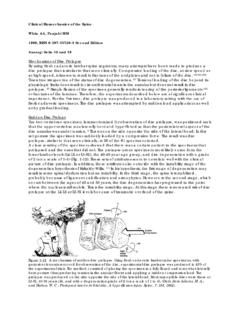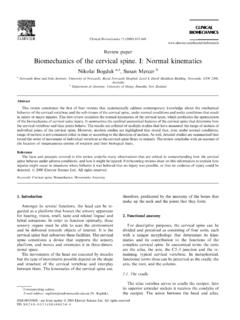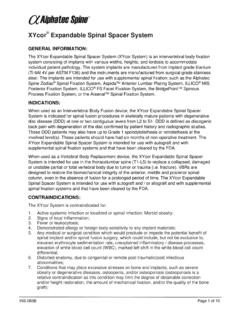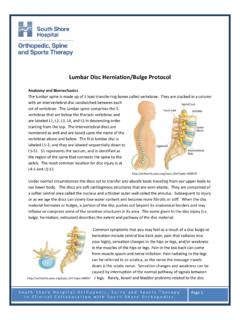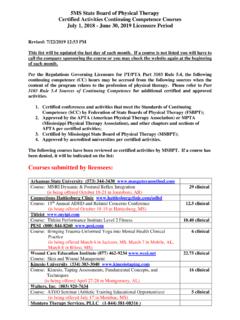Transcription of II) Chiropractic Guideline for Spine Radiography for the ...
1 DRAFT(c) 2006 PCCRPII) Chiropractic Guideline for Spine Radiography for the Assessment of Spinal Subluxation in Children and Adults RECOMMENDATION Radiography is indicated for the qualitative and quantitative assessment of the biomechanical components of vertebral subluxation. When using Radiography , a baseline value for subluxation displacement should be determined prior to the initiation of and at the cessation of a program of Chiropractic treatment interventions. In this manner, patient response to care can be accurately determined. Supporting Evidence: For all radiographic views combined (not separated out as in Section X): Clinical Levels I-V, Biomechanics, Reliability Class 1 and 2, and Validity. PCCRP Evidence Grade: Clinical Studies = B, C, and PCCRP Consensus Opinion = D, Biomechanics, Reliability and Validity Studies = a. A. Introduction to General Radiography Radiography is a proven procedure for visualizing human anatomy and in particular spinal structures.
2 The goal of Radiography in Chiropractic is to: 1. Make an assessment of spinal subluxation; 2. Make a determination of spinal health including the presence of any soft tissue injury, presence of any fractures, and the presence of any bony pathologies; 3. Make an assessment of any spinal instabilities; 4. Make an assessment any disc and other degenerative changes. Historically, Palmer termed the use of Radiography in Chiropractic to assess the Spine as Spinography . The term Spinography provides for a Chiropractic focus and is defined as: Spinography is the Chiropractic art of analyzing x-rays for the following purposes: 1. Finding potential subluxations. 2. Understanding the anatomy to give the most appropriate adjustment. 3. Developing the most appropriate plan of care for the patient. In the current PCCRP guidelines , we will use the term Spinography and spinal Radiography /x-ray analysis by the Doctor of Chiropractic interchably; the intended meaning is as defined by Palmer.
3 Since the Doctor of Chiropractic has studied courses in x-ray physics, radiographic positioning, radiographic safety, radiographic diagnosis, and radiographic geometric line drawing analysis, he/she is expected to have a license to practice that is controlled by a government agency (State and Provincial Chiropractic Boards). As such, the Chiropractic practitioner is expected to adhere to the local laws pertaining to x-ray equipment, x-ray safety, and all other such items that are concomitant with x-ray privileges granted by a government. Some specific items of importance for the Chiropractic practitioner are listed here. These items include: 1. Principles of radiation protection, including shielding of various body parts, lead aprons, etc, 2. Proper screens and cassettes, 3. Proper film identification (patient name, age, date, clinic), 4. Proper identification of direction (left, right, oblique, etc), 5. Best visualization with a minimal exposure, DRAFT(c) 2006 PCCRP6.
4 Appropriate Collimation, 7. Appropriate technique charts with exposure factors, 8. Radiographs should be reviewed before a patient is released for that day to insure that positioning and film quality is at an optimum. B. Indications for Spine Radiography in Children and Adults The main focus of this document is the following list of patient conditions that warrant a radiographic evaluation for the assessment of spinal subluxation. This evaluation for the assessment is independent of any Red Flags assessment. For the assessment of spinal subluxations, the Chiropractor becomes aware of conditions which affect the safety and appropriateness of Chiropractic care by conducting a consultation that should include a personal history, family history, present complaints, and any recent or past traumas. Additionally, an orthopedic, neurological, range of motion (ROM), and a postural examination may be helpful. Indications for Spine radiographic examinations include, but are not limited to: 1.
5 Abnormal posture, 2. Spinal Subluxation (as defined in this document), 3. Spinal deformity (eg, scoliosis, hyper-kyphosis, hypo-kyphosis, ), 4. Trauma, especially trauma to the Spine , 5. Birth Trauma (eg, forceps, vacuum extraction, caesarean section ), 6. Restricted or abnormal motion, 7. Abnormal gait, 8. Axial pain, 9. Radiating pain (eg, upper extremity, intercostal, lower extremity), 10. Headache, 11. Suspected short leg, 12. Suspected spinal instability, 13. Follow-up for previous deformity, previous abnormal posture, previous spinal subluxation/displacement, previous spinal instability, 14. Suspected osteoporosis, 15. Facial pain, 16. Systemic health problems (eg, skin diseases, asthma, auto-immune diseases, organ dysfunction), 17. Neurological conditions, 18. Delayed developmental conditions, 19. Eye and vision problems other than corrective lenses, 20. Hearing disorders (eg, vertigo, tinnitus, ), 21. Spasm, inflammation, or tenderness, 22. Suspected abnormal pelvic morphology, 23.
6 Post surgical evaluation, 24. Suspected spinal degeneration/arthritis, 25. Suspected congenital anomaly, 26. Pain upon spinal movement, 27. Any Red Flag Conditions covered in previous guidelines . DRAFT(c) 2006 PCCRPC. Minimum Spine Radiographic Examination Since the Spine is a contiguous structure that is inseparable in function it should be inseparable in an evaluation using Spinography. A radiographic examination of the Spine may include an AP evaluation and a lateral evaluation of the entire Spine . Additional views may be indicated in cases involving trauma. It is of some historical interest that the recommendations of Hildebrandt1 in 1985 are repeated here. In his classic 1985 text Chiropractic Spinography, Hildebrandt1 suggested that there are five projections that comprise a complete full Spine analysis: 1. AP full Spine 2. Lateral full Spine 3. Femoral head view 4. Sacral base view 5. Upper cervical view. For children younger than 10 years old, some of the five projections may not be needed, and the Chiropractor may use clinical judgment to determine which views are needed.
7 If we pause to understand the reasoning behind Hildebrandt s1 suggested five views for a complete Spine evaluation, we may be able to elaborate on his suggestions. First, the lateral full Spine view will provide an analysis of several possible spinal subluxations: 1. a global view of the sagittal balance of C1, T1, T12, and S1, 2. an evaluation of forward/backward head posture, 3. an evaluation of forward/backward ribcage posture, 4. an evaluation of sagittal posture (from the postural examination) and spinal coupling on the radiograph, 5. an evaluation of cervical lordosis, 6. an evaluation of thoracic kyphosis, 7. an evaluation of lumbar lordosis, 8. an evaluation of pelvic morphology, 9. an evaluation of any retro- or spondylo-listhesis and, 10. an evaluation of spinal degeneration (vertebrae, discs, spinal ligaments). If the Chiropractor does not have a full Spine bucky and cassettes to obtain a full Spine lateral x-ray, then three sectional views may substitute for this view.
8 These sectional views are: lateral cervical, lateral thoracic, and lateral lumbo-pelvis. Second, the AP full Spine view will provide an analysis of several possible spinal subluxations including; 1. a global view of the AP balance of C1, T1, T12, S1, 2. an evaluation of segmental subluxations in the cervical, thoracic, and lumbar regions, 3. an evaluation of posture (knowledge from the postural examination) and spinal coupling on the AP radiograph, 4. an evaluation of any cervical scoliosis, 5. an evaluation of any thoracic scoliosis, 6. an evaluation of any lumbar scoliosis, and 7. an evaluation of pelvic and leg length asymmetry. DRAFT(c) 2006 PCCRP If the Chiropractor does not have a full Spine bucky and cassettes to obtain a full Spine AP x-ray, then three sectional views may substitute for this view. These sectional views are: AP cervical, AP thoracic, and AP lumbo-pelvis. While the items listed above for the AP full Spine and lateral full Spine analysis may seem straight forward, one might ask why Hildebrandt1 suggested the femur head view, the sacral base view, and the upper cervical view (Nasium).
9 To change from the fetal C-shape curve, the cervical vertebrae extend and the lumbar vertebrae extend. This extension to eventually assume an upright stance is restricted to the median-sagittal plane. Thus, while the spinal structures in the sagittal view are normally aligned perpendicular to the central ray, this extension of the Spine to allow upright stance creates a situation where the AP x-ray beam is at an angle to the plane of the lower lumbar segments (L4-L5-S1) and upper cervical segments (C0-C1-C2) in the AP view. Additionally, any pelvic axial rotation in front of the grid cabinet will project one femur head lower than its twin on the other side. Thus, taken together the femur head view, the sacral base view, and the upper cervical view (Nasium) allow for assessment of the following subluxation types: 1. short leg causing an un-level sacral base and spinal AP curvatures on the short leg view, 2. an evaluation of the SI joints, sacral ala, L5, and L4, and lumbo-sacral angle at the sacral base on the Ferguson projection, 3.
10 An evaluation of the skull-atlas and atlas-cervical Spine as upper angle (UA), lower angle (LA), C2 axial rotation, and cervico-dorsal (CD) angle at mid neck on the AP nasium upper cervical view. Patients expect and deserve a thorough radiographic evaluation of their spines when any of the above indications are By following this minimal radiographic set of views, the vast majority of structural spinal subluxations can be located and measured. However, there are additional radiographic views needed to perform a thorough investigation in trauma and deformity cases. These may include all or part of the following list: 1. Davis Cervical Series: a. AP cervical, b. Lateral cervical, c. AP Open Mouth (APOM), d. Flexion, e. Extension, f. Left oblique, g. Right oblique, 2. Sand bag stress views in cervical lateral bending (alar ligament views), 3. Cervical Motion X-ray during flexion-extension, open-mouth lateral bending, and oblique lateral bending cervical articular facet views, 4.

